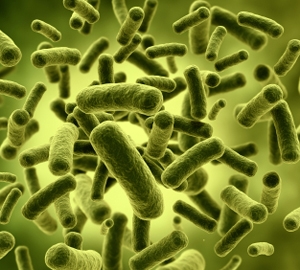May 9 2013
Researchers from UNSW have cautioned that more work is needed to understand how micro-organisms respond to the disinfecting properties of silver nano-particles, increasingly used in consumer goods, and for medical and environmental applications.
 Artist's impression of Bacillus bacteria. A new study has shown that while silver nanoparticles effectively killed E.coli cells, they also caused another bacteria (Bacillus sp.) to rapidly adapt and flourish. (Credit: iStock photo)
Artist's impression of Bacillus bacteria. A new study has shown that while silver nanoparticles effectively killed E.coli cells, they also caused another bacteria (Bacillus sp.) to rapidly adapt and flourish. (Credit: iStock photo)
Although nanosilver has effective antimicrobial properties against certain pathogens, overexposure to silver nano-particles can cause other potentially harmful organisms to rapidly adapt and flourish, a UNSW study reveals.
This result, published in the journal Small, could have wide-reaching implications for the future use of nanosilver as an antimicrobial agent with biomedical and environmental applications.
“We found an important natural ability of a widely occurring bacteria to adapt quite rapidly to the antimicrobial action of nanosilver. This is the first unambiguous evidence of this induced adaptation,” says co-author Dr Cindy Gunawan, from the UNSW School of Chemical Engineering.
Using an experimental culture, UNSW researchers observed that nanosilver was effective in suppressing a targeted bacteria (Escherichia coli), but that its presence initiated the unexpected emergence, adaptation and abnormally fast growth of another bacteria species (Bacillus).
The efficacy of nanosilver to suppress certain disease-causing pathogens has been well-documented, and as a result, it has become widely used in medicine to coat bandages and wound dressings. It also has environmental uses in water and air purification systems, and is used in cosmetics and detergents, and as a surface coating for things like toys and tupperware.
But the researchers say this exploitation of nanosilver’s antimicrobial properties have “gained momentum due in part to a lack of evidence for the potential development of resistant microorganisms”.
“Antimicrobial action of nanosilver is not universal and the widespread use of these products should take into consideration the potential for longer-term adverse outcomes,” says Gunawan.
The researchers say these adverse impacts could be more pronounced given the near-ubiquitous nature of the Bacillus bacteria, which originate from airborne spores, and because the resistance trait can potentially be transferred to the genes of other micro-organisms.
“For the medical use of nanosilver, this implies the potential for reduced efficacy and the development of resistant populations in clinical settings,” says co-author Dr Christopher Marquis, a senior lecturer from the UNSW School of Biotechnology and Biomolecular Sciences.
“This work suggests caution in the widespread use of nanosilver and the requirement for much deeper research into the antimicrobial mechanisms, the extent of adaptability and the molecular basis or genetics of cell defence against the antimicrobial activity.”